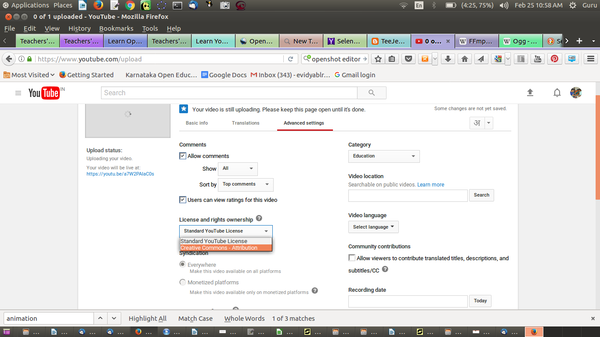Difference between revisions of "Teachers' toolkit for creating and re-purposing OER using FOSS/Publishing OER"
| Line 1: | Line 1: | ||
| + | {{Navigate|Prev=File formats|Curr=Publishing OER|Next=Annexure}} | ||
| + | |||
The power of OER is in its re-use by others, creating a rich learning environment. You benefit from OER, by being able to access a variety of resources for your various learning and teaching needs. Likewise, it is important for you to publish the OER you create or re-purpose, so that it is available to others (for re-use or re-purposing), to sustain a virtuous cycle of receiving-giving. | The power of OER is in its re-use by others, creating a rich learning environment. You benefit from OER, by being able to access a variety of resources for your various learning and teaching needs. Likewise, it is important for you to publish the OER you create or re-purpose, so that it is available to others (for re-use or re-purposing), to sustain a virtuous cycle of receiving-giving. | ||
Revision as of 08:01, 27 February 2017
The power of OER is in its re-use by others, creating a rich learning environment. You benefit from OER, by being able to access a variety of resources for your various learning and teaching needs. Likewise, it is important for you to publish the OER you create or re-purpose, so that it is available to others (for re-use or re-purposing), to sustain a virtuous cycle of receiving-giving.
It is also important for you to access existing OER, revise them to make them more valuable (by improving their accuracy or comprehensiveness, by contextualising them, by translating them etc.), and publishing the revised OER. Such re-purposing and publishing will make it easier for others to get OER that they want.
You have so far maintained your OER in your own computer in your personal digital library. This is accessible only to you. However if you publish your OER on the world wide web, it will be accessible to anyone, any time. Publishing content on-line is making a copy of your personal digital library available on the global digital library, that the web is.
You can publish your OER in popular OER repositories, some of which have been mentioned earlier in this toolkit. This chapter briefly discusses OER repositories where you could publish the OER you create or re-purpose.
Publishing text OER
You can create your own (blog) site on Wordpress. If you would like to upload all your OER in a single place to make it available to others, this is a good option. Wordpress is a simple software for you to manage your web content.
There are many OER repositories for uploading your text resources. WikiEducator is a repository specially for sharing educational content. Slideshare and Academia.edu are popular web sites where you can upload your presentation slides and text documents.
You can also contribute your content to Wikipedia. In case the page does not exist in Wikipedia, you can create the page as well, this is the way this encyclopedia has grown to be the most referred to encyclopedia. You can edit the relevant page in Wikipedia, if it page is already existing. Contributing to Wikipedia is even more important if you are creating an OER in a language other than English. Most languages of the world are not well represented on Wikipedia (see List of Wikipedias), especially languages spoken in the developing countries. Since Wikipedia is a very popular encyclopedia, if you could regularly contribute your OER to Wikipedia, it would be useful to many others. You will need to follow the editing guidelines of Wikipedia.
As mentioned, you should publish in formats that are open and easier to edit. A web page is usually in the .html format which is an open format. In case you are uploading a document (file) on-line, you should prefer an odt over a pdf format (editable v/s non-editable) for publishing a text document. Again you should prefer an odt over a docx format (open v/s closed formats).
Remember always to specify the license of the OER you upload. If you do not specify any license, then the default license 'all rights reserved' will apply, which will make your content a non-OER. You can choose from a variety of Creative Commons licenses.
Publishing image OER
Image OER can be uploaded on Wikimedia commons. Other options include Flickr
Publishing audio and video OER
Audio OER can be uploaded on Soundcloud
Video OER can be uploaded on Youtube. You should ensure to select the Creative Commons license when you upload your video OER, to ensure that it is available freely to others.
Image - Specifying CC license for video uploaded on Youtube

Vimeo is another popular site for uploading OER videos.
The table below provides the web spaces available for you to publish your OER.
| No | Category | Site for publishing OER on-line |
| 1 | Text OER | Wikipedia, Wikieducator |
| 2 | Text OER – Presentations | Slideshare, Academia |
| 3 | Image OER | Wikimedia commons |
| 4 | Audio OER | Soundcloud |
| 5 | Video OER | Youtube, Vimeo |
Note
- Before uploading your OER, you will need to register or create a login id on the site
- You need to ensure that you have not used any non-open (copyright) materials in making your OER.
Popular OER repositories
- Some of the large-scale repositories created through the OER movement include
- OpenCourseWare,
- OER Commons,
- Merlot
- Khan Academy
- OpenLearn
Pages or articles listing OER repositories
You can get a list of OER repositories from the following web pages:
- Wikipedia
- WikiEducator
- COL Workshop on OER
- DiscoverEd from the Creative Commons
- Edutopia
- Nova Library